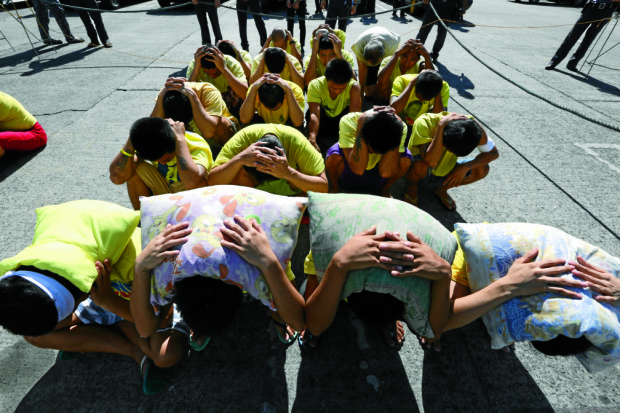Civilians, military get ready for ‘Big One’

Marikina City jail inmates duck, cover and hold during the National Simultaneous Earthquake Drill, April 21, 2016.
INQUIRER PHOTO / NINO JESUS ORBETA
CLARK FREEPORT—As part of the preparation for the “Big One” in Metro Manila, the national government on Thursday tested the readiness of the Philippine Air Force (PAF) facility here as a backup command center for disaster response.
The PAF’s Haribon hangar, reused after the United States left the former Clark Air Base in June 1991, served as site of the exercise in the event a 7.2-magnitude earthquake expected in Metro Manila because of the Valley Fault System (VFS).
A siren that rang for five minutes signaled the start of the 9 a.m. drill.
Defense Secretary Voltaire Gazmin, chair of the National Disaster Risk Reduction and Management Council (NDRRMC), and Social Welfare Secretary Corazon “Dinky” Soliman joined the exercise.
“The drill is the people’s response here and the command center operation in Clark is in response to severe damage in Metro Manila,” said Renato Solidum, chief of the Philippine Institute of Volcanology and Seismology (Phivolcs).
“You need to have a backup command center,” he said.
Clark, 100 kilometers north of Metro Manila, would “not be significantly affected” by a 7.2-magnitude temblor.
Haribon hosts several hangars and repair centers and stands next to the Clark International Airport, making the movement of personnel, equipment and goods faster, according to Josefina Timoteo, regional head of the NDRRMC.
The East Valley Fault straddles 10 kilometers in Rizal province, while the West Valley Fault runs more than 100 km through Metro Manila and Rizal, Bulacan, Cavite and Laguna provinces.
Solidum said the potential risks from a 7.2-magnitude quake were higher in Metro Manila, with a population of more than 10 million.
Without any interventions and should it strike at night, the Big One in Metro Manila could kill 31,000 people and seriously injure 130,000 people, Phivolcs said.
Experts believe the valley fault is “ripe,” based on its pattern of movement every 600 years.
Solidum said the NDRRMC had scheduled more earthquake drills. “It is already in the mindset of the NDRRMC to continue the earthquake drills. There is a planned drill for Metro Manila and surrounding provinces,” he added.
Government agencies and private companies participated in the drill, with people practicing the duck-cover-hold technique.
“There is no right time to be prepared than now,” Timoteo said.
At the regional police headquarters in Camp Olivas in Pampanga province, police and fire protection personnel conducted the drill. Some 200 of them evacuated to the parade ground after dropping to the ground, finding cover and holding on.
Soliman said a lesson learned from the 2013 Supertyphoon “Yolanda” (international name: Haiyan), which devastated the Visayas was the need for a large space where assets and aid could be accommodated.
“In Tacloban City, the airport can fit only two C-130 planes. Here, we could fit in as many as we want,” she noted.
For the first time, the NDRRMC operations center was placed outside Metro Manila for the quarterly drill as organizers wanted to consider the possibility that a 7.2-magnitude quake can level the seat of government and paralyze even disaster response operations.
Corazon Jimenez, general manager of the Metropolitan Manila Development Authority, said the second Metro Manila earthquake drill would be held in June. The provinces of Bulacan, Cavite, Laguna and Rizal will join the event.
“We are already planning the next drill and we want to incorporate our past experiences so we can improve our response. For one, there is a need to improve the communication, I had a hard time making contact,” she noted.














